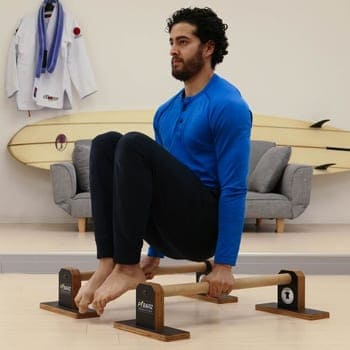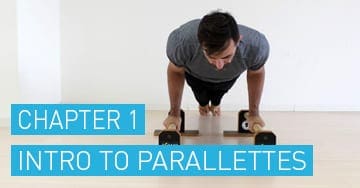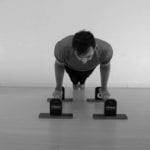 Parallettes training is a lot of fun, helping you build foundational strength while giving you an opportunity to play with skills you probably haven’t even considered since you were a child playing on the bars on the playground.
Parallettes training is a lot of fun, helping you build foundational strength while giving you an opportunity to play with skills you probably haven’t even considered since you were a child playing on the bars on the playground.
Training with parallettes challenges strength and mobility while improving wrist and hand strength in a way that’s not very common in traditional strength and conditioning programs, and throughout this guide, we’ll teach you how to get the most of this versatile training tool.
In this chapter, we’ll lay out the benefits–and challenges–of training with this tool, along with ways to troubleshoot and maintain your forward momentum. Let’s dive in.
Three Benefits on Why You Should Train with Parallettes
Do you want to improve your pressing strength? Or perhaps you secretly want to be able to do arm balances, but you don’t think you possess the basic strength and coordination to even begin to support your body weight in your arms.
Maybe you have a hard time training on your hands because they fatigue or you don’t have the necessary wrist strength/flexibility required, but you still want the benefits of pushing strength. Parallettes training gives you the underlying strength, body awareness, and motor control to do all of these things and more.
And because your hands are fixed in a position that doesn’t require a ton of wrist extension, you don’t have to worry about stressing the wrist structure. Let’s start with pressing strength.
1. Build Pressing Strength
 Pressing strength is what helps you do a push-up, L-sit, and handstand, but it’s also necessary for all sorts of sports (e.g. bench pressing for powerlifters, or pushing your opponent off of you in martial arts), as well as real life needs (e.g. pushing your car out of traffic if it breaks down).
Pressing strength is what helps you do a push-up, L-sit, and handstand, but it’s also necessary for all sorts of sports (e.g. bench pressing for powerlifters, or pushing your opponent off of you in martial arts), as well as real life needs (e.g. pushing your car out of traffic if it breaks down).
There are two types of pressing strength: bent arm and straight arm.
Bent arm pressing strength is what happens when you hold the bottom of a push-up. It’s the strength required to lower yourself into a triceps dip, and it’s also the starting point for approaching many hand balancing positions (for instance, bent arm crow is the precursor to the straight arm crane).
Straight arm pressing strength is what happens at the top of a push-up, in a handstand, and in an L-sit. If you want strength that translates into other areas of your life, it’s important to have both types of pressing strength.
One of the great things about training pressing strength on the parallettes is it gives you an opportunity to focus on the positions without worrying about your hand placement.
The parallettes provide a constraint, which means they eliminate concern about where to place the hands or how to put weight in the fingers, allowing you to worry about one less body part and focus on building strength and control.
They also change the angle of your torso relative to your feet because your hands are elevated. This creates more space to get your legs under you when you are working on the preparatory strength for moves like the L-sit, again, allowing you to focus on the necessary actions at the shoulders and upper arms to make your triceps light up.
This angle also allows you to focus on perfecting the form for the push-up and plank because gravity is a little bit kinder when your hands are even slightly higher than your feet.
The pressing strength built using the parallettes will carry over into other pressing skills.
2. Ease in to Arm Balances
 One of the trickiest parts of learning arm balances isn’t the strength–it’s actually figuring out how to balance your torso over your arms. There are a number of things that come into play to allow an arm balance to happen, such as arm position, torso position, and the direction the elbows point.
One of the trickiest parts of learning arm balances isn’t the strength–it’s actually figuring out how to balance your torso over your arms. There are a number of things that come into play to allow an arm balance to happen, such as arm position, torso position, and the direction the elbows point.
All of this requires a fair amount of wrist mobility and strength.
Training on the p-bars allows you to practice arm balances with your hands in a closed fist position, holding on to something. By changing the angle of the load on the wrist, you can begin practicing skills and finding your balance.
The fixed hand position also makes it easier to figure out how to support yourself through the upper arms and back. The muscles that support the shoulder work together to provide stability to the upper extremities when you are finding a balance point. It’s easier to feel the stability when you aren’t worrying about what the hands should be doing.
In a move like the L-sit, for instance, you can take the time to focus on the set-up in the arms, chest, back, and legs and really feel how pushing down into the bars creates the strength to lift the legs up.
3. Work Around Wrist Restrictions
 Maybe putting weight on your hands hurts because you have limitations in flexibility or you have a previous injury.
Maybe putting weight on your hands hurts because you have limitations in flexibility or you have a previous injury.
Training with parallettes lets you work on gaining strength and mobility through your upper body while strengthening your wrists in a neutral position.
The hand position used on the parallettes bars has the added benefit of helping you feel a connection with the muscles that stabilize the shoulder and strengthen the triceps. This strength carries over to other positions, including skills with your hands flat on the floor.
Avoiding strength loss when you are recovering from an injury can feel frustrating, and often the options available for training are less fun than when you are healthy.
Using parallettes while you are recovering from a wrist injury can help you maintain–and gain–upper body strength. Plus, training with the parallettes is fun, an added bonus when you are working on keeping your training going during a set-back.
For a little inspiration, or to learn more about using the parallettes while recovering from a wrist injury, check out best selling author Josh Hillis’s story here.
Overcoming the Three Biggest Challenges of Training with Parallettes
For all of the benefits that come along with parallettes training, it’s important to consider potential challenges, and to be armed with strategies for overcoming those challenges if and when you face them.
1. Wrist and Hand Pressure
 I know I listed this as a benefit of training with the parallettes–and it is! But depending on your particular circumstances, you may find the positioning and pressure of your hands on the parallettes to be uncomfortable.
I know I listed this as a benefit of training with the parallettes–and it is! But depending on your particular circumstances, you may find the positioning and pressure of your hands on the parallettes to be uncomfortable.
There are a number of ways to improve the sensation of the hands against the bars, starting with getting used to placing your hands on them.
Positions where the majority of your weight is in your hands are the ones where your hands are going to feel most of the pressure. Tuck holds and inverted presses tend to be exercises where people notice their wrists the most.
Build up to these exercises by starting with a low set/rep scheme, and if you are following our Parallettes One program, make sure to use the lower recommendations at first as your wrists and hands get used to bearing weight in the fisted position.
It also helps to think about how your structure supports you in the various positions.
For instance, in the tuck position, your hands should press down into the bars, moving your shoulders down, and moving the torso away from the floor. You will feel your abs, lats, and triceps in a big way, which results in you feeling less pressure in the hands.
By focusing on form and not rushing the process, your hands and wrists will adapt to the position and eventually won’t be a limiting factor.
2. Working at Your Level
 It’s really easy to want to jump into more advanced exercises. They look cool and are fun; plus, the elevation provided by the parallettes makes certain exercises, like push-ups, feel easier.
It’s really easy to want to jump into more advanced exercises. They look cool and are fun; plus, the elevation provided by the parallettes makes certain exercises, like push-ups, feel easier.
However, it’s important to remember strength, flexibility, and coordination take time to develop, and jumping ahead before you’re ready can be an especially bad idea on the parallettes (for instance, if things go wrong with a hand balancing move you’re not ready for, bailing is not an option like it would be on the ground).
Take your time and work on the basics, even if they feel easy. Refinement will enable you to progress to more advanced skills and make the process far more enjoyable–and safer!
3. Transitioning to the Floor
 The benefits of working in a slightly elevated position and taking pressure off the wrists can also become a crutch. Let’s look at this a little more closely.
The benefits of working in a slightly elevated position and taking pressure off the wrists can also become a crutch. Let’s look at this a little more closely.
The parallettes bars are a training tool. They will improve strength, body mechanics, and coordination; however, they are not a replacement for skill work on the floor, so if your goal is to one day do handstands on the floor, you don’t want to become so reliant on the parallettes bars that you are afraid to work with your hands in a flat position.
There are a couple of easy solutions to this.
One of the best things you can do when you are training on the parallettes is to work on your wrist mobility. Not only will it likely improve your parallettes training, you will develop the flexibility and strength needed to work skills on the ground.
It’s also a good idea to have a bridging period, where you work on skills on the parallettes as well as on the floor, to make the transition smoother.
Get All the Benefits with a Full Parallettes Workout Routine
There are many benefits of training with parallettes, and now that you understand how to avoid or overcome challenges, I’m sure you’re raring to go! In the next chapter, I’ll give you a full parallettes routine to get you started.
Want to go even further with your p-bar training? Check out our Parallettes One courses.








